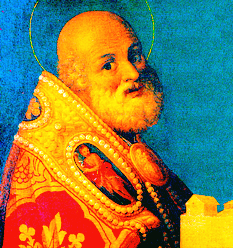St. Martin was made bishop of Tours in 371 CE. The job was too conspicuous for his taste, so he founded an abbey in 372 into which he could withdraw from the press of public life. Martin's contemporary, Sulpicius Severus, in his biography of St. Martin, describes the restrictions Martin placed on those who wished to join him:
No one there had anything which was called his own; all things were possessed in common. It was not allowed either to buy or to sell anything, as is the custom among most monks. No art was practiced there, except that of transcribers, and even this was assigned to the brethren of younger years, while the elders spent their time in prayer. Rarely did any one of them go beyond the cell, unless when they assembled at the place of prayer. They all took their food together, after the hour of fasting was past. No one used wine, except when illness compelled them to do so. Most of them were clothed in garments of camels' hair. Any dress approaching to softness was there deemed criminal, and this must be thought the more remarkable, because many among them were such as are deemed of noble rank.
This was prior to the strict set of rules for monastic living formulated by St. Benedict and adopted by so many abbeys.
The abbey fell on had times when the Normans invaded and damaged it in 853, killing over 100 monks. Abbot Majolus of Cluny (Cluny was mentioned here) restored it in 982; a generation later, it was thriving and becoming one of the richest abbeys in Europe. You can read here how a monk of the abbey attended the Battle of Hastings and suggested to William the Conqueror that an abbey be built on the site. That abbey was "seeded" with monks from Marmoutier, which led Marmoutier to claim control over it, but the idea was rejected.
Now it is a Catholic school, the Institution Marmoutier, whose webpage begins Sur les pas de Saint Martin, symbole universel du partage. "In the footsteps of St. Martin, the universal symbol of sharing."
Time to take a closer look at St. Martin, I think.






























